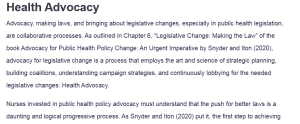Health Advocacy
Advocacy, making laws, and bringing about legislative changes, especially in public health legislation, are collaborative processes. As outlined in Chapter 6, “Legislative Change: Making the Law” of the book Advocacy for Public Health Policy Change: An Urgent Imperative by Snyder and Iton (2020), advocacy for legislative change is a process that employs the art and science of strategic planning, building coalitions, understanding campaign strategies, and continuously lobbying for the needed legislative changes: Health Advocacy.
Nurses invested in public health policy advocacy must understand that the push for better laws is a daunting and logical progressive process. As Snyder and Iton (2020) put it, the first step to achieving significant legislative change is to be persuasive to the right people and boards to pass new or change existing laws. This means persuading the state and federal legislature, local county council, or county board of supervisors.
This requires finding one or more legislators willing to carry and present the bill to the House or board. Health advocates must get a legislator they trust and one who is willing to proactively fight for the bill. This requires creating a relationship with both the legislator and the constituents and proving that the issue is of concern and it is imperative to introduce the bill and take a legislative action.
Finding a legislator willing to present the bill is not enough. Advocacy, being a logical, progressive process, means that one must draft the bill and frame it in a manner that aligns with the legislator’s beliefs and is reflective of the issues and needs of the people. Advocates must get the right legislative staff to draft the bill on their behalf based on the issues and solutions they have identified and presented. Drafting the bill transforms the idea into actionable language and highlights the bottom line of the bill.
Regardless of how well the bill is drafted, legislative advocacy is a collaborative team effort. Accordingly, getting the right people and groups in agreement before even persuading the legislator to carry the bill is crucial. The advocate must create the right coalitions, including collaborating with other nursing and health policy advocacy groups, community organizations, and other campaign groups. It is important to understand that the policy advocacy process and the process of making legislative changes and laws have no permanent foes and allies (Snyder & Iton, 2020).
Advocates need everyone, regardless of their political stand or views, to push for the bill. As such, advocacy requires adopting various campaign tools to amplify the reach and create enough buzz on the issues and the bill. This is why broad coalitions with diverse stakeholders are important to achieve the needed support.
Although the next steps, such as hearings, floor votes, and having the bill signed into law, may be mostly out of control, they are an important part of the legislative and policy advocacy process. They are the result of all advocacy efforts. Advocates must get to know which committees will be voting, the current opposition, and how much evidence will be required to compel the legislature to vote and pass the bill. They must also ensure that they have the mayor’s, governor’s, or president’s signature for the process to be successful and the bill ascended into a public health law.
Overall, the “Legislative Change: Making the Law” chapter is extremely educative and creates a clear understanding of the process of advocacy and what is required to achieve meaningful legislative changes and create new public health policies. An interesting thing about the chapter is the constant reminder about often overlooked aspects of advocacy, such as budgeting, the need for adaptability, and the interconnectedness between legislation and courts in judicial oversight and the legislature in administrative execution. Therefore, appreciating the complexity of public health policy, the need for evidence, and collaborative partnerships helps to create and achieve significant changes and developments in public health policy.
References
Snyder, M. H., & Iton, A. B. (2020). Advocacy for public health policy change: An urgent imperative. American Public Health Association (APHA) Press.
ORDER A PLAGIARISM-FREE PAPER HERE
We’ll write everything from scratch
Question 
PH 528 Blog 1
Begin by reading “Legislative Change: Making Law”, a chapter from Advocacy for Public Health Policy Change: An Urgent Imperative (Snyder & Iton, 2020). A scanned copy of the book chapter is seen above.

Health Advocacy
After reading this chapter, write a blog entry with a 400-word minimum that summarizes and reflects on this content- what you found interesting, surprising, or noteworthy. This is a lot of content, and I do not expect you to cover it all. Rather, I’d like you to write a cohesive entry that discusses your thoughts and shows an understanding of the wide breadth of content covered in this chapter.